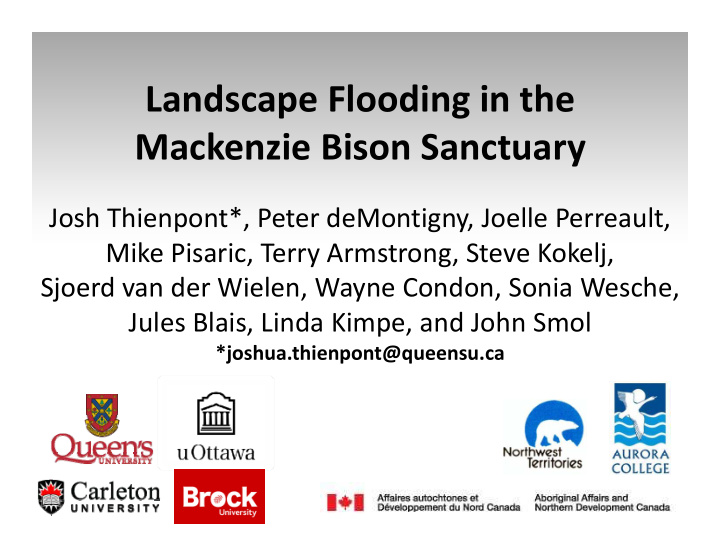



Landscape Flooding in the Landscape Flooding in the Mackenzie Bison Sanctuary Josh Thienpont*, Peter deMontigny, Joelle Perreault, Mike Pisaric, Terry Armstrong, Steve Kokelj, ik i i k lj Sjoerd van der Wielen, Wayne Condon, Sonia Wesche, Jules Blais, Linda Kimpe, and John Smol l l i i d i d h S l *joshua.thienpont@queensu.ca
Mackenzie Bison Sanctuary Mackenzie Bison Sanctuary • ~150 km SW of Yellowknife 150 km SW of Yellowknife • East of the community of Fort Providence • >10,000 km 2 protected wildlife reserve • Home to between 2000 ‐ 3000 wood bison ( Bison bison athabascae) • Contains wetlands, thousands Contains wetlands, thousands of small ponds and several large, shallow lakes
1984 ‐ 08 ‐ 02
1986 ‐ 09 ‐ 09
1988 ‐ 07 ‐ 12
1990 ‐ 08 ‐ 03
1992 ‐ 09 ‐ 09
1994 ‐ 08 ‐ 30
1996 ‐ 07 ‐ 18
1998 ‐ 08 ‐ 09
2000 ‐ 09 ‐ 23
2002 ‐ 09 ‐ 13
2004 ‐ 08 ‐ 09
2006 ‐ 09 ‐ 16
2008 ‐ 08 ‐ 05
2009 ‐ 08 ‐ 16
2010 ‐ 08 ‐ 09
Falaise Lake Falaise Lake Year: 2000 Year: 2010
Caen Lake Caen Lake Year: 2000 Year: 2010
Caen Lake
Implications for Bison Management p g • The MBS herd are naturally disease (tuberculosis and brucellosis) free unlike some other populations (such as in WBNP) free, unlike some other populations (such as in WBNP) • Interaction between the MBS herd and infected animals could introduce widespread i t d id d infection into the MBS herd • Expanding lakes are encroaching on wood bison habitat, encouraging the habitat, encouraging the bison to migrate out of the core area of the MBS, towards the diseased herds towards the diseased herds
Multiple Sources of Knowledge / Methods 1. Timeline of water level changes 1 Timeline of water level changes T diti T diti Traditional / Traditional / l / l / Natural Archives Natural Archives Remote Sensing Remote Sensing Local Knowledge Local Knowledge Mid ‐ range Distant Past Recent past past (100s ‐ 1000s yrs) (40 yrs) (40 200 yrs) (40 ‐ 200 yrs)
Traditional & Local Knowledge Traditional & Local Knowledge 2 Causes of water level changes? 2. Causes of water level changes? 3. Impacts on people in the community? 4 How to plan for future changes? 4. How to plan for future changes? Traditional / Local Knowledge Mid ‐ range Recent Present Present Future Future past past (40 ‐ 200 yrs)
Traditional Knowledge Component S W S. Wesche, Dept. of Geography, University of Ottawa, swesche@uottawa.ca h D t f G h U i it f Ott h @ tt • March 2012: – Community workshop and initiation of Traditional C i k h d i i i i f di i l Knowledge component • October 2012: – Community visit (S. Wesche) – 7 interviews conducted 7 interviews conducted • Next steps: – Interview transcript analysis l – Community workshop: February 2013 • Preliminary results presentation and community feedback – Collaborative discussion about ongoing research and application of results
Tree Ring Analysis ( (Dendrochronology) d h l ) • The width of annual rings in Th idth f l i i trees is related to climatic factors such as temperature factors, such as temperature and precipitation • Changes in width can be used to reconstruct long ‐ term l climate over the last few h hundred years d d deMontigny et al. in prep
Fort Providence tree ring chronology Palmer Drought Severity Index Tree rings suggest climate in the area has become wetter since 1915 Tree rings suggest climate in the area has become wetter since 1915 deMontigny et al. in prep
Lake Sediments: Environmental Archives Lake Sediments: Environmental Archives Close ‐ interval sectioning Present ‐ day Pre ‐ disturbance Pre disturbance
Falaise Lake – Mercury ? **Note these values are below the Canadian Sediment Quality Guidelines for the id li f h Protection of Aquatic Life (170 ng/g dw) Perreault et al. unpublished data
“Jackie” Lake – Mercury • Air photo analysis to be p y conducted for this lake • Field observation suggests some recent expansion **Note these values (drowned terrestrial are below the Canadian Sediment Quality Sediment Quality vegetation observed) Guidelines for the Protection of Aquatic Life (170 ng/g dw) Perreault et al. unpublished data
Conclusions and Future Work • Proxy records indicate the region is wetter than the early 20 th century 20 th • Lake expansion may be mobilizing mercury in aquatic systems t • Future research will focus on tracking the cyclicity of (any) past lake expansion and assessing mercury in the (any) past lake expansion and assessing mercury in the aquatic food web of impacted lakes • We will continue to work with community members and • We will continue to work with community members and leaders to identify ongoing research needs and how these results should be applied pp
Acknowledgements • Deh Gah Gotie Dene Band (Fort Providence) • Cumulative Impact Monitoring Program • NSERC • Polar Continental Shelf Program • Aurora Research Institute • Aurora Research Institute • Great Slave Helicopters
Recommend
More recommend